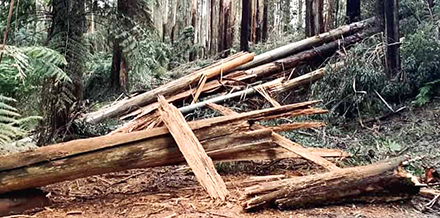We wonder if a tree falls in a forest with no one around whether it makes a sound, but if a forest is flattened in a windstorm, will it increase fire risk? That’s the burning question surrounding the Wombat State Forest, which was hit by storms last June that came with unprecedented severity, leaving widespread damage and vast areas of fallen trees on the ground.
Tree fall is normal in the forest. In fact, it is an important process contributing to coarse woody debris and critical species habitat on the forest floor.
But the scale and extent of damage caused by last year’s storms is beyond ecologically normal levels and the fallen trees represent a real danger to both adjacent human communities and wildlife, due to the extreme fuel loads.
With climate change elevating the risk and impact of severe climatic events like storm and fire, it has never been more important to ensure that we manage our forests to be their most resilient. When informed by scientific best-practice and Indigenous knowledge and performed by trained experts respecting the wide range of environmental, social and cultural values held in our forests, we can do this, and yes, sometimes it involves chainsaws and bulldozers.
Timber recovery operations, or the act of removing timber debris from areas affected by storms, fire or flood in forests, are the necessary, and the only practical, measure to ensure these areas of highest fire risk are effectively managed ahead of the bushfire season.
There is a range of benefits of timber recovery after severe weather damage.
Firstly, it reduces fire risk through minimising fuel loads and removing barriers to access for firefighters to conduct future fire prevention or suppression activity. This clean-up also facilitates the future ability of traditional owners and land managers to undertake other management that would otherwise be nearly impossible in the presence of such high fuel loads.
Secondly, in removing the trees, it makes sense to make use of this valuable natural resource before it degrades and goes to waste. In this case, the recovery of timber will provide benefit to the Dja Dja Wurrung and local timber and firewood to the community, which is currently in short supply.
Finally, timber recovery ensures that forests are safer places for people to access for work, travel, recreation and practising culture.
To achieve the best possible outcomes, planners and managers must ensure detailed consideration is given to supporting structural diversity across the forests, through retaining live habitat trees, and an ecological level of coarse woody debris on the ground to support populations of arboreal and ground-dwelling animals, forest birds and other flora and fauna.
The Wombat Forest has endured through a difficult European history of exploitation. It is a forest that continues to require stewardship, so its values are protected and restored.
After the windstorms of 2021, targeted and well-regulated timber recovery, in accordance with the wishes of the Dja Dja Wurrung, is but another chapter in that stewardship.
- Dr Michelle Freeman is the vice president of Forestry Australia






